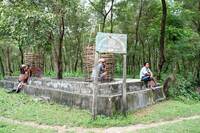Community forestry requires land, money and laws. They often exist in traditional societies, as in Nepal, but need to be re-enacted in industrialized societies.
Many countries have become interested in 'community forestry' and a group of Canadian foresters has suggested the following definition: 'a tree-dominated ecosystem managed for multiple community values and benefits by the community' (Duinker et. al. 1994). It is a local, rather than national, approach to forestry. In principle:
costs should be met by communities
ownership should be local and public
management policies should be set locally
benefits should accrue locally
The Menominee Indian Reservation is a 'superb example of a successful community forest in the US' , and an example of 'the land ethic in practice' (Pecore, 1990). The reserve was established in 1854 and the tribe leaders used selection forestry to balance annual yield with timber growth. Income from the forest pays for social services, medical services, education and law enforcement. As a European example, we can take the city of Hameenlinna in Finland, which owns some 10,000 ha of forest land. It is zoned as follows: economic forest, for timber production; landscape forest, for multiple use, sports and recreation forest; special forest, for education and nurseries. The city employs a professional forester, a forest technician and about 20 staff. It makes money by selling timber and fishing licenses and by letting the public hunt small game (Duinker et. al. 1994).
Britain launched a policy for community forestry in 1987 (Countryside Commission, 1987). The strength of the policy was that a 'forest' was conceived not merely as a dense woodland. It embraced farmland, water bodies and recreational land. The weakness of the policy was the lack of any intention to take a significant proportion of the designated 'forest' into community ownership, or to allow local communities to make policy or management decisions. With these drawbacks, 'community forests' have been shown on maps but can be detected on the ground only from the occasional country park and the thin strips of grant-aided trees planted on private land. The lesson of history remains to be learned: effective forestry requires land, money, laws and wise management over many years.

